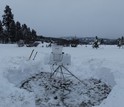Researchers study whether cloud seeding increases snowfall
 Pilots from Weather Modification, Inc., prepare the cloud seeding aircraft with seeding flares. Credit and Larger Version |
January 13, 2017
Can cloud seeding -- dispersing particles into the air with the aim of increasing precipitation -- increase snowfall? This week, a team of researchers began a cloud-seeding project in southwestern Idaho to answer that question.
Cloud seeding is a process by which artificial ice nuclei, such as silver iodide particles, are released into clouds, either from the air or via ground-based generators.
The Idaho project, funded by the National Science Foundation (NSF) and dubbed SNOWIE (Seeded and Natural Orographic Wintertime Clouds -- the Idaho Experiment), will run from January 7 to March 17 in and around the Payette Basin, 50 miles north of Boise.
"Scientists are still uncertain about cloud seeding for increasing precipitation, despite ongoing operations around the globe," says Nick Anderson, program director in NSF's Division of Atmospheric and Geospace Sciences. "SNOWIE is the most comprehensive study to date on cloud seeding in winter."
More snow?
Snow from winter storms develops when ice crystals form on dust and other particles known as "ice nuclei." In many storms, the lack of natural ice nuclei at warmer temperatures results in less precipitation. In addition, weak updrafts in clouds and other factors limit the ability of ice nuclei to form.
In some areas affected by droughts, cloud seeding may increase mountain snowfall and, ultimately, water supplies for communities and for crop irrigation. Water resource managers, hydropower companies and agriculture businesses usually pay for the practice, seeing it as a potential way of alleviating water shortages.
"SNOWIE researchers have an array of advanced instrumentation and modeling to focus on the fine-scale aspects of clouds to determine whether seeding operations are resulting in precipitation enhancement," Anderson says. "Improved information about cloud seeding, and winter precipitation in general, is especially important for water resources, such as those related to hydropower and for agriculture."
SNOWIE: A multi-institution collaboration
SNOWIE researchers, led by atmospheric scientist Jeff French of the University of Wyoming, are working in concert with the Boise-based Idaho Power Company, which obtains a large amount of its power through hydroelectric dams. The company is covering the cost of cloud seeding and some instrumentation.
"Idaho Power is interested in putting more snow on the ground in the mountains, which leads to more water in rivers from snowmelt," says French. "In turn, that leads to more power generation capability throughout the year."
Researchers aboard an aircraft provided by Idaho Power will release silver iodide into the atmosphere, while scientists on the NSF-funded University of Wyoming King Air plane will take measurements to help understand the effects. The King Air is a twin turbo-prop aircraft designed and used for atmospheric research.
Along with University of Wyoming researchers and the Idaho Power Company, scientists at the University of Colorado, the University of Illinois at Urbana-Champaign, the National Center for Atmospheric Research (NCAR) and the Center for Severe Weather Research are participating in SNOWIE.
The project has a series of intensive observation periods, during which the researchers will obtain measurements while cloud seeding is happening and when it's not.
"Part of understanding seeding is understanding the natural processes of a winter storm," French says. "It's important to be out there during a storm's evolution to take measurements even when seeding is not occurring."
Research in the air and on the ground
While much of the research will take place aboard the King Air, some will take place on the ground. The team will model precipitation using the Cheyenne supercomputer at the NCAR-Wyoming Supercomputing Center. The models will simulate clouds and snowfall -- created in natural storms and with cloud seeding -- over the Payette Basin.
"Results from SNOWIE will lead to a new and important understanding of cold-season precipitation -- both natural precipitation and precipitation augmented through cloud seeding -- and will have an impact throughout the American West, a region that increasingly suffers from drought and water shortage," French says.
For more on NSF-supported snow projects, please see The Science of Winter.
-NSF-
Media Contacts Cheryl Dybas, NSF, (703) 292-7734,
cdybas@nsf.gov
Ron Podell, University of Wyoming, (307) 766-2929,
rpodell@uwyo.edu
The National Science Foundation (NSF) is an independent federal agency that supports fundamental research and education across all fields of science and engineering. In fiscal year (FY) 2016, its budget is $7.5 billion. NSF funds reach all 50 states through grants to nearly 2,000 colleges, universities and other institutions. Each year, NSF receives more than 48,000 competitive proposals for funding and makes about 12,000 new funding awards. NSF also awards about $626 million in professional and service contracts yearly.
Useful NSF Web Sites:
NSF Home Page: https://www.nsf.gov
NSF News: https://www.nsf.gov/news/
For the News Media: https://www.nsf.gov/news/newsroom.jsp
Science and Engineering Statistics: https://www.nsf.gov/statistics/
Awards Searches: https://www.nsf.gov/awardsearch/
The NSF-supported University of Wyoming King Air research plane taxis across an icy tarmac.
Credit and Larger Version

A Doppler-on-Wheels radar unit operates from a remote mountaintop location.
Credit and Larger Version

Researchers prepare to launch an instrument package.
Credit and Larger Version

Snow gauges, operated by the National Center for Atmospheric Research, measure how much snow falls.
Credit and Larger Version

A radiometer from the University of Colorado measures how much supercooled liquid clouds contain.
Credit and Larger Version
The National Science Foundation (NSF)
Guillermo Gonzalo Sánchez Achutegui
ayabaca@gmail.com
ayabaca@hotmail.com
ayabaca@yahoo.com
Inscríbete en el Foro del blog y participa : A Vuelo De Un Quinde - El Foro!

No hay comentarios:
Publicar un comentario